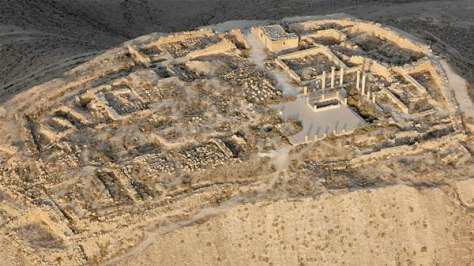John the Baptist and Salome’s Dance Floor

The beheading of John the Baptist is a well-known story. Even many who aren’t familiar with the New Testament have heard the story of the dance of Salome that cost John his head. Artists throughout the ages have dramatized the grizzly scene of John’s head being brought on a plate by the young girl (see above). Recently, Győző Vörös, director of the excavations at Machaerus, announced that he has pinpointed the area where Salome’s deadly dance took place.
Herod’s Palace Fortress at Machaerus


The Gospel accounts of John the Baptist’s Death
In order to avoid any confusion, I would point out that, although Herod the Great had refurbished the palace, it was Herod’s son, known as Herod Antipas, who figures in the story of John’s beheading. The Gospels record that John accused Herod (Anitpas) of violating the Law of Moses by taking his brother’s wife. Herodias was previously married to Antipas’s brother Philip (Mark 6:17-20). Antipas arrests John and throws him in prison, not willing to kill him for fear of the people who regarded John as a prophet. However, when Salome, Herodias’s daughter, dances for Herod, he promises her anything, up to half his kingdom. Her request is for the head of John the Baptist, which Herod reluctantly grants.
Josephus’s Account of John the Baptist’s Death

As noted above, Josephus also provides an account of John the Baptist’s death. Josephus’s account differs in some particulars. His account compliments the Gospels by adding additional information. I have provided an abbreviated version of his account below:
But to some of the Jews the destruction of Herod’s army seemed to be divine vengeance, and certainly a just vengeance, for his treatment of John, surnamed the Baptist. For Herod had put him to death, though he was a good man and had exhorted the Jews to lead righteous lives, to practice justice toward their fellows and piety towards God, and so doing join in baptism. . . . When others too joined the crowds about him, because they were aroused to the highest degree by his sermons, Herod became alarmed. Eloquence that had so great an effect on mankind might lead to some form of sedition, for it looked as if they would be guided by John in everything that they did. Herod decided therefore that it would be much better to strike first and be rid of him before his work led to an uprising, than to wait for an upheaval, get involved in a difficult situation and see his mistake. Though John, because of Herod’s suspicions, was brought in chains to Machaerus, the stronghold that we have previously mentioned, and there put to death, yet the verdict of the Jews was that the destruction visited upon Herod’s army was a vindication of John, since God saw fit to inflict such a blow on Herod (Josephus Ant 18.5.2 §116–19).
Josephus’s mention of the destruction of Antipas’s army relates to the defeat he suffered in 36 AD at the hands of the Nabatean King Aretas IV. Anitpas had divorced his daughter in order to marry Herodias.
Where Did Salome’s Dance Take Place?
An artistic representation by Vörös of what this courtyard may have looked like can be found in the following article by livescience entitled, “Dance floor where John the Baptist was condemned to death discovered, archaeologist says” (Go to the bottom of the article). A short article in Bible History Daily also contains some artistic reconstructions of the palace. A short video about Machaerus by The Watchman program can be found here and a longer version can be found here.
As with any archaeological reconstruction, 100% certainty is not possible. Some archaeologists have agreed with Vörös’s conclusions, while others are not convinced. In any case, Salome’s dance certainly happened within this palace in a place where Herod would have entertained guests. This seems to be the most likely spot. The work at Machaerus continues and perhaps even greater clarity about where this biblical event took place will be forthcoming.


















